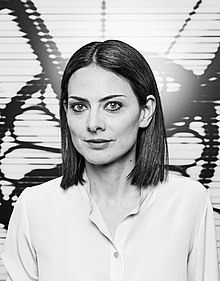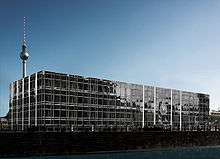Bettina Pousttchi
Bettina Pousttchi (born 1971 in Mainz, Germany) is a German-Iranian artist. She lives and works in Berlin. The artist works with photography, sculpture, video and site-specific installations to explore systems of time and space in a transnational perspective.
Bettina Pousttchi | |
|---|---|
 Bettina Pousttchi in front of one of her works from the series World Time Clock 2016 | |
| Born | 1971 Mainz, Germany |
| Nationality | German-Iranian |
| Occupation | Artist |
Life
Bettina Pousttchi studied at the Kunstakademie in Düsseldorf with Prof. Rosemarie Trockel and Prof. Gerhard Merz from 1995 until 1999. Subsequently, she attended the Whitney Independent Studio Program of the Whitney Museum of American Art in New York. In 2001 she began exhibiting her work internationally. She participated twice in the Venice Biennale (2003, 2009). In 2014 the artist received the Wolfsburg Art Prize.
Work

Façades in public space
Since 2009, Bettina Pousttchi has been realizing photographic interventions on public buildings, which are related to the urban and historic context of each particular place. Her monumental photo installation Echo on Schlossplatz in Berlin covered the entire exterior façade of the Temporäre Kunsthalle for half a year. Extending nearly 2,000 square meters, the installation consisted of 970 different paper posters, and formed a continuous motif that recalled the Palast der Republik (Palace of the Republic), the building which had just been demolished on that very site. On the façade of Art Basel 2010, she mounted Basel Time, a large photo installation that alluded to the imminent demolition of the hall as part of a redesign of Basel's Messeplatz. At the Schirn Kunsthalle Frankfurt, the artist presented the site-specific photo installation Framework (2012) in its rotunda and on its eastern façade. This work's point of departure was the building's historical and urban context. In London, she conceived the photo installation Piccadilly Windows (2013) for the Hauser & Wirth Gallery building on Piccadilly, covering their windows with a photographic pattern. In 2014, the artist transformed the Nasher Sculpture Center Dallas into a Drive-Thru Museum, referencing the site's history and the architecture of the Renzo Piano building. Her up to now largest photo installation to this point is The City (2014), which covered three sides of the Wolfsburg castle with a 2,150 square meter photographic print. The photomontage shows ten skyscrapers that have been the world's highest buildings, grouping them together into an imaginary single transnational skyline.
At the Arts Club of Chicago she realized in 2017 the photo installation Suspended Mies, referring to the Arts Club´s Mies van der Rohe staircase, a commission from the architect for a previous building.
Over the summer of 2018 a freestanding pavilion by Bettina Pousttchi was commissioned by Neues Museum Nürnberg. Located on Klarissenplatz in front of the museum, the photo pavilion UNN (United Nations Nuremberg) recalled the history of Nuremberg and its relevance for the development of international human rights.
World Time Clock
The project World Time Clock is the artist's most comprehensive photographic series to date for which she travelled eight years in several stages in the world's various time zones. In each of the places she photographed public clocks always at the same time; 1,55 pm. Thus arose a work spanning the entire globe which examines the political and social organization of time and space in such cities as New York, London, Hongkong, Sydney, Tashkent, Cape Town, Dubai, Moscow, Mexico City, Yangon, Rio de Janeiro etc. The 24-part photo series premiered 2016 at the Smithsonian's Hirshhorn Museum and Sculpture Garden in Washington DC in a 360-degree presentation. The curator of the presentation, Melissa Ho, comments "World Time Clock visualizes a new world order, one that lacks a center but runs in a circuit through 24 equal hubs." The director of the Hirshhorn Museum, Melissa Chiu calls the series "A poetic contemplation on global synchronicity and the structuring of time."[1] This experience of nonlinear temporal structure is to be found in many of the artist's works.
Double Monuments and further sculptures
Everyday objects of urban space like crowd barriers, street bollards and bicycle racks occur frequently in the artist's sculptures and, in the tradition of object art, she transforms them. The sculpture series Double Monuments for Flavin and Tatlin consist of deformed crowd barriers and neon tubes, which function as a double hommage to Vladimir Tatlin’s Monument to the Third International as well as Dan Flavin’s "monuments" for V.Tatlin. It debuted in her extensive solo exhibition at the Kunsthalle Basel 2011. The Phillips Collection in Washington DC presented 2016 five of these sculptures in dialogue with their collection. At the 2009 Venice Biennale, Pousttchi's sculpture Cleared, consisting of two crowd barriers made of security glass, was part of the Glasstress exhibition.
The use of these objects address questions of limits, the forces at work therein, and the transformative energy released by passing them, underlining the artist´s transnational approach to her work.
Video installations
The artist's video works initially consisted of single channel works and subsequently evolved into spatially encompassing video installations. In these installations it is often the projected space which continues on into the exhibition hall and the various levels of reality blend into one another.
Works in public collections
Bettina Pousttchi's work is represented in the collections of numerous international museums such as the Hirshhorn Museum and Sculpture Garden in Washington DC, the Phillips Collection in Washington DC, the Arts Club of Chicago, the Nasher Sculpture Center in Dallas, the Berlinische Galerie – Museum of Modern Art Berlin, the Albertina in Vienna, the Von-der-Heydt Museum Wuppertal, the Kunsthalle Bielefeld, as well as in the collection of the Federal Republic of Germany.[2]
Collaborations
Bettina Pousttchi is a member of the Brutally Early Club, founded by Hans-Ulrich Obrist and Markus Miessen in London in 2006 along with Shumon Basar, Tom McCarthy, Zak Kyes, Charles Arsene-Henry, Marina Abramović, Ingo Niermann, Sam Thorne and Jefferson Hack. She has also taken part in a film by Lawrence Weiner (How Far Is There, 1999). With Daniel Buren she produced an interview video in 2010 on artistic practice in public spaces Conversations in the Studio #3. This video work became the starting point for a joint exhibition by both artists in the Kunsthalle in Mainz in 2017.
Selected solo exhibitions
- Berlinische Galerie, Museum of Modern Art Berlin (2019/2020)
- KINDL – Centre of Contemporary Art Berlin (2019/2020)
- Kunsthalle Tübingen (2019/2020)
- Neues Museum Nürnberg (2018)
- Kunstmuseum St. Gallen (2018)
- Kunsthalle Mainz (with Daniel Buren) (2017)
- The Arts Club of Chicago (2017)
- Hirshhorn Museum and Sculpture Garden, Washington D.C (2016/2017)[3]
- Phillips Collection Washington D.C. (2016)[4]
- Nasher Sculpture Center, Dallas (2014)[5]
- Städtische Galerie Wolfsburg (2014)
- Schirn Kunsthalle Frankfurt (2012)
- Kunsthalle Basel (2011)
- Temporäre Kunsthalle Berlin (2009/2010)
- Von der Heydt-Kunsthalle, Wuppertal (2007)
- Württembergischer Kunstverein Stuttgart (2003)
- Museum Morsbroich, Leverkusen (2001)
Grants and awards
- Villa Aurora Fellow, Los Angeles (2016)
- Wolfsburg Art Prize (2014)
- TrAIN Research Center for Transnational Art, Identity and Nation, Balmoral Residency, University of the Arts, London (2008)
- BBAX – Berlin Buenos Aires Art Exchange, Buenos Aires (2007)
- Provinzial Förderprojekt (2005)
- Kunststiftung NRW (2000)
Literature/Monographs
- Bettina Pousttchi: In Recent Years, Berlinische Galerie, Museum of Modern Art, Berlin, Koenig Books, London, 2020, with texts by Thomas Köhler, Jörg Heiser, Jeremy Strick, Melissa Ho, ISBN 978-3-96098-819-9
- Bettina Pousttchi: Metropolitan Life, Museo Nivola, Scheidegger & Spiess, 2018, with an essay by Greg Foster-Rice and a conversation with the artist by Hans Ulrich Obrist and Markus Miessen ISBN 978-3-85881-826-3
- Bettina Pousttchi: World Time Clock, Hirshhorn Museum and Sculpture Garden Washington D.C.,/ Hatje Cantz, 2017, with texts by Melissa Chiu and Melissa Ho, ISBN 978-3-7757-4359-4
- Bettina Pousttchi: Suspended Mies, The Arts Club of Chicago 2017, with texts by Janine Mileaf and Greg Foster-Rice, ISBN 978-1-891925-48-1
- Bettina Pousttchi: The City, Nasher Sculpture Center Dallas / Städtische Galerie Wolfsburg, Hatje Cantz 2015, essays by Susanne Pfleger, Thomas Köhler, Jeremy Strick, Adam Szymczyk, and a conversation between the artist and Chris Dercon, ISBN 978-3-7757-3908-5
- Bettina Pousttchi: Framework, Schirn Kunsthalle Frankfurt, Verlag der Buchhandlung Walther König Köln, 2012, with texts by Max Hollein, Katharina Dohm, Adam Szymczyk and a conversation between Bettina Pousttchi and Nikolaus Hirsch, introduction by Max Hollein, ISBN 978-3-86335164-9
- Bettina Pousttchi: Echo Berlin, Temporäre Kunsthalle Berlin, Verlag der Buchhandlung Walther König Köln, 2010, with texts by Tom McCarthy, Diedrich Diederichsen, Markus Miessen, Hans Ulrich Obrist, Bettina Pousttchi, Angela Rosenberg, Esther Ruelfs, ISBN 978-3-86560-833-8
- Bettina Pousttchi: Reality Reset, Von der Heydt Museum Wuppertal, Verlag der Buchhandlung Walther König, Köln, 2008, with texts by Barry Schwabsky, Jörg Heiser, Matthias Mühling, Petra Löffler, Niels Werber, Uta Grosenick, Jon Wood, Christian Rattemeyer, Mark Gisbourne, Vanessa Joan Müller, ISBN 978-3-86560-374-6
- Bettina Pousttchi: Departure, Verlag der Buchhandlung Walther König, Köln, 2007, ISBN 3-86560-285-1
References
- Bettina Pousttchi: World Time Clock, Hirshhorn Museum and Sculpture Garden Washington D.C.,/ Hatje Cantz, 2017, with texts by Melissa Chiu and Melissa Ho, ISBN 978-3-7757-4359-4
- Zeitblick: Ankäufe der Sammlung Zeitgenössischer Kunst der Bundesrepublik Deutschland 1998–2008, Dumont 2008
- Exhibition Announcement Archived 22 February 2016 at the Wayback Machine. Retrieved 15 March 2016.
- Exhibition Announcement. Retrieved 15 March 2016.
- Exhibition Announcement. Retrieved 1 August 2014.
External links
| Wikimedia Commons has media related to Bettina Pousttchi. |
- Bettina Pousttchi in the German National Library catalogue
- http://www.pousttchi.com
- Bettina Pousttchi at Buchmann Galerie Berlin
- Glasstress Bettina Pousttchi at the Venice Biennale